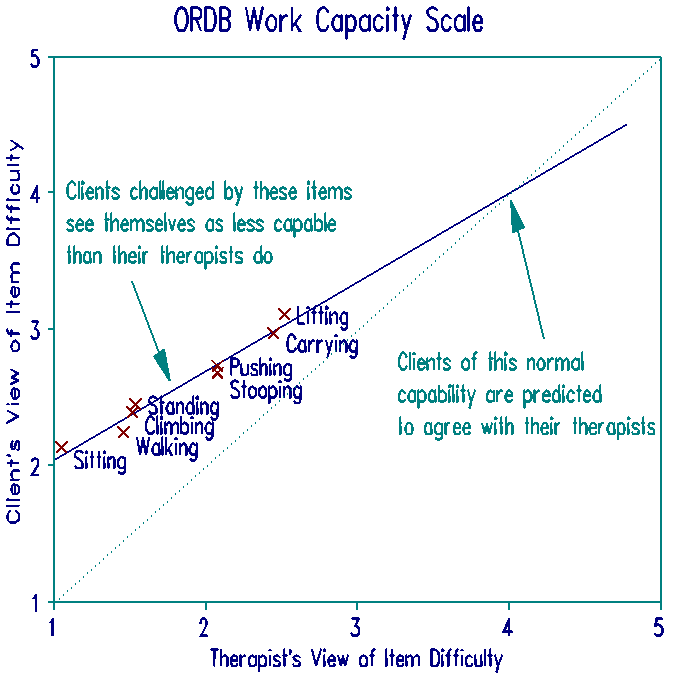
Clients vs. therapists. Gerardi S, Eckberg S. … 1995, 8:4 p.399
A common opinion in medical rehabilitation is that patients feel more disabled than their therapists perceive them to be. Successful therapy requires the therapist to act as though the patient can almost "do it" - that success is almost within reach. Patients, however, in their need for help and sympathy, often act as though they are in a worse state than they appear to be.
Support, clarity and hope are provided by the Occupational Rehabilitation Database (ORDB) collected in a 1994 study funded by the American Occupational Therapy Foundation. 230 clients from 28 rehabilitation sites across the USA rated themselves at rehabilitation admission and discharge. They were also rated by their therapists. The plot compares the item calibrations.

There were 8 physical movement items on the protocol. Clients rated themselves lower than their therapists did. Clients saw themselves as less effective than their therapists did. Overall, clients reported the items to be .75 logits more challenging than did their therapists. Thus clients were functioning .75 logits less capably in their own minds than in the reports of their therapists. This supports and quantifies the anecdotal evidence.
The plot also reaches beyond the common wisdom. The plot shows a trend. The less incapacitated the client, the smaller the discrepancy between client and therapist views. As clients heal, they see themselves performing better. Then the items becoming suitable for them (the harder items: carrying, lifting..) are reported ever closer to the way their therapists see them. Extrapolating onwards, we reach a point, corresponding to normal functioning, at which clients and therapists agree. To confirm this extrapolation, more demanding items could be devised and administered to suitably capable clients.
The hope lives in the trend-line. Now we can transform measures based on patient self-ratings and therapist-based measures onto the same scale of reference. This simplifies the clinical task of assessment, and opens the door to tracking patient progress, even over the telephone.
Clients vs. therapists. Gerardi S, Eckberg S. … Rasch Measurement Transactions, 1995, 8:4 p.399
| Forum | Rasch Measurement Forum to discuss any Rasch-related topic |
Go to Top of Page
Go to index of all Rasch Measurement Transactions
AERA members: Join the Rasch Measurement SIG and receive the printed version of RMT
Some back issues of RMT are available as bound volumes
Subscribe to Journal of Applied Measurement
Go to Institute for Objective Measurement Home Page. The Rasch Measurement SIG (AERA) thanks the Institute for Objective Measurement for inviting the publication of Rasch Measurement Transactions on the Institute's website, www.rasch.org.
| Coming Rasch-related Events | |
|---|---|
| Jan. 16 - Feb. 13, 2025, Fri.-Fri. | On-line workshop: Rasch Measurement - Core Topics (E. Smith, Winsteps), www.statistics.com |
| Apr. 8 - Apr. 11, 2026, Wed.-Sat. | National Council for Measurement in Education - Los Angeles, CA, ncme.org/events/2026-annual-meeting |
| Apr. 8 - Apr. 12, 2026, Wed.-Sun. | American Educational Research Association - Los Angeles, CA, www.aera.net/AERA2026 |
| May. 15 - June 12, 2026, Fri.-Fri. | On-line workshop: Rasch Measurement - Core Topics (E. Smith, Winsteps), www.statistics.com |
| June 19 - July 25, 2026, Fri.-Sat. | On-line workshop: Rasch Measurement - Further Topics (E. Smith, Winsteps), www.statistics.com |
The URL of this page is www.rasch.org/rmt/rmt84j.htm
Website: www.rasch.org/rmt/contents.htm